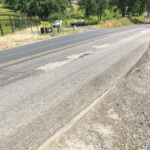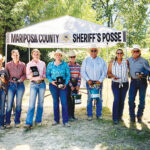
Former sheriffs recount challenges and career highlights over almost four decades
By R.D. Tucker
Thanks to its semi-remote geographic location, diminutive population, and typically a law-abiding rural citizenry, Mariposa County has traditionally been a safe place to work, live and raise a family. Even today, the tentacles of rising crime throughout the state don’t often penetrate the daily existence of the county’s inhabitants.
The atmosphere surrounding law enforcement, especially in California, has changed drastically over the past few years. The state’s progressive legislators aren’t interested in prosecuting those who violate the law. They are more dedicated to dealing a stack of “get out of jail free” cards to law enforcement officers who would prefer to use them as tinder.
Over the past 39-plus years, dating back to 1985, there are five men who have served as the most powerful law enforcement officer in the county – Mariposa County Sheriff. These public servants, all born and raised in Mariposa County and graduates of Mariposa County High School, directly affected the lives of both today’s and yesteryear’s residents.
The Mariposan reached out to the last five sheriffs of the county with these four basic questions:
1. What years did you serve in the capacity of Sheriff of Mariposa County?
2. What was your most challenging case or event during your term and why?
3. What was your most disturbing case, and why?
4. How did the law enforcement environment change during your tenure?
The following are the responses of Sheriff Roger Matlock who served the county from 1986 to 1998.
1. “What years did you serve in the capacity of Sheriff of Mariposa County?” I was elected, by majority vote, as Sheriff-Coroner in the June 1986 Primary Election. I formally requested the Board of Supervisors appoint me to the vacant position of Sheriff-Coroner effective August 1,1986. I retired on December 31,1998. I proudly served our county for 12 years (3 full terms) and 5 months.
2. “What was your most challenging case or event during your term and why?” The January 1997 flood of the Merced River. It started on Dec. 31,1996 and continued to Jan. 5, 1997, peaking on Jan. 2. It endangered hundreds of people in Yosemite National Park, Mariposa County and beyond. Not only our sheriff’s department responded to this natural disaster but there was a coordination of other agencies as well (federal, state, and other county departments), Additionally we provided safety for our residents and visitors to the Merced River canyon.
3. “What was your most disturbing case, and why?” All homicide cases are disturbing to me. I felt we dealt with these serious cases as they occurred with investigations both here and out of county. Background checks of all persons involved were solicited; we sent deputies to outlying areas as far as Alaska and Texas as I remember. We were successful in bringing people to justice.
4. “How did the law enforcement environment change during your tenure?” During my tenure a new Sheriff’s Administration Building and a new 58-bed Adult Detention Facility was built. The old Sheriff’s office/jail was remodeled to house the upgraded Dispatch Center. The administrative team upgraded the Sheriff’s Department with the latest technology for both administrative and field operations (enhanced 9-1-1 system, video arraignment between the court and the jail facility, wireless computer connections between the jail and the sheriff’s dispatch building, the use of pagers, later cell phones and laptop computers were added and the Sheriff’s Office webpage was developed and updated daily). Animal Control was improved, and the constable function was merged with the Sheriff’s Office. Twenty-four-hour patrol was started, as well as an Investigation Division.
We held team building workshops to create cohesiveness and to provide better understanding of the functions of each section of the department as to the importance of working together for the betterment of Mariposa County. The community-based law enforcement programs that were developed and/or enhanced included: the DARE program, the Scope program, bicycle patrol, Search and Rescue, Posse, and Reserves. At the time there were over 160 citizen volunteers participating.
The following are the responses of Sheriff James “Jim” Allen who served the county from 2003 to 2007.
1. “What years did you serve in the capacity of Sheriff of Mariposa County?)” I served as Sheriff from May 1, 2003, to Dec. 30, 2007. I served with the Sheriff’s Office in Mariposa County for 31 years. I started as a Reserve Deputy Sheriff in May 1976, and became a full-time employee as a jail officer/dispatcher in July 1977. In Dec. 1979, I became a Deputy Sheriff/Coroner. I worked and/or supervised each function within the office and held every rank. On May 1, 2003, I was appointed Sheriff/Coroner by the Board of Supervisors of Mariposa County. The board added the responsibility of Public Administrator. I was elected as Sheriff/Coroner/Public Administrator in June 2006.
2. “What was your most challenging case or event during your term and why?” The most challenging event was retention of deputies and jail officers. As I wrote and explained to the Board of Supervisors: On Friday, March 17, 2006, I attended a meeting with the Board’s Public Safety Committee. In attendance was Supervisor Turpin, Fritz, County Administrative Officer Rich Inman, Captains Bibby, Binnewies, Undersheriff Muller, District Attorney Bob Brown and myself.
During these discussions I had requested an olive branch to show good faith so I could stop the bleeding, i.e.; stop employees from leaving. I requested that the board offer the Deputies (Deputy Sheriffs Association – DSA) and Sheriff Management organizations the same medical/dental/vision/deferred comp as they do for MCMCO – ($1005.87) and pay the three and a half percent on the retirement.
This would give the deputies an immediate $400 net in their monthly paycheck, which would help them with their monthly bills. Discussions were made and assurances were given that a generous offer would be made by the CAO to both the Management and DSA. There were also a few procedural areas addressed which would be submitted in two weeks for board approval: pay for new hire uniforms, overfill of positions by three and overtime for management employees during staffing shortages.
It was stated that the new proposal would be made on Monday. I asked if we could do it today, so we didn’t have to go through another weekend of turmoil. It was agreed to meet with both associations on Friday. I called the DSA president and asked him to gather his team and meet with the CAO. He said he could be there at 1 p.m.
The Sheriff’s Management met and received an offer that on its face appeared reasonable. They asked for this to be written in contract form. When they received this in contract form it was much different than what was presented. It’s like buying a car; you see the price but when you read the fine print, it’s no deal! The DSA offer was, in my opinion, worse. The olive branch turned into a poison oak branch. I again had an office with its employees very upset and looking elsewhere for employment.
I noted that, “On the current consent agenda you are spending $28,000 and $19,000 for advertising in Sunset and AAA magazines that would more than pay for additional medical benefits for the deputies.”
I requested their immediate intervention on behalf of the citizens of Mariposa County and myself as Sheriff, or I would continue to lose employees. It was not a threat, but a fact, with the two deputies that notified the board last Tuesday that they would be seeking employment elsewhere. That would further reduce my patrol staff from 29 to 18, which was devastating.
3. “What was your most disturbing case, and why?” As a deputy it was the death of three children in a house fire in Greeley Hill in 1983-1984 as well as the SIDs (sudden infant death syndrome) deaths.
As Sheriff, it was the death of Reverend Hibpshman by his brother Mr. Branson in Midpines. When the call came into dispatch they paged me. At the time I was traveling through Midpines with my family going to Yosemite to go ice skating. I had them drop me off at the Midpines Store and I caught a ride with the first arriving deputy. We located his brother later that afternoon just past Colorado Road at a residence. We called the Merced SWAT team. Early the next morning the SWAT team was successful in talking him out of the house.
The other disturbing losses were two of our finest deputies Phil Rauch on May 9, 2003, and Art Schneider on Sept. 2, 2003.
Sergeant Phillip Rauch Jr. was a veteran of 13 years and Art Schneider, who started as a SCOPE volunteer and then became a jail officer in August of 2001. He then transferred to become a Deputy Sheriff on June 15, 2002. They both touched the lives of everyone they came in contact with. Their compassion and concern for the residents of Mariposa County was second to none. They were always there to help others either on or off duty. They both were everything a law enforcement officer should be, loyal and dedicated.
Another seriously disturbing case was the disappearance of “Grandpa” Doug Pearse. This is the press release that my office released about that event: (May 2, 2005) “The Mariposa County Sheriff’s Office Search and Rescue efforts were suspended on Saturday evening regarding missing 86-year-old Mariposa resident, Grandpa Doug Pearse who was reported missing on the afternoon of April 21, 2005, after his vehicle was found abandoned in the Summit Camp area of Mariposa County. The massive search which included the best search teams and resources in California were unable to find Grandpa Doug. Lead by the Mariposa County Sheriff’s Search and Rescue, assisted by SCOPE and Sheriff’s Offices from the following counties: Alameda, Calaveras, Contra Costa, El Dorado, Fresno, Kern, Los Angeles, Madera, Marin, Merced, Mono, Napa, Placer, San Bernardino, San Joaquin, San Mateo, Santa Barbara, Santa Clara, Stanislaus, Tehama, Tulare, Tuolumne, Ventura. Assisting in the search efforts were Yosemite National Park, California Explorer Search and Rescue, Wilderness Finders Search Dog Team (WOOF), California Rescue Dog Association (CARDA), California Highway Patrol, California National Guard, U.S. Forest Service, California Office of Emergency Service.
Sheriff Allen wishes to thank all the searchers for their unselfish and dedicated work during this search. He would also like to recognize all the support and donations from the residents and business during these search efforts. A special thank you to the Chowchilla Mountain Women’s Club and the Fire Department for their hospitality and allowing us to utilize their building for our Search Base.
Grandpa Doug will be missed but remembered in our hearts for his giving and caring to all of our children. I would like nothing more than to bring Grandpa Doug home.
Search efforts will resume if new information is received. During the search efforts there have been investigators assigned to process and investigate the disappearance of Grandpa Doug. This investigation is still ongoing.”
4. “How did the law enforcement environment change during your tenure?” During my years as Sheriff, we were being challenged often regarding deputy/officer behavior. We issued digital tape recorders to all officers to record interactions. By doing this we were able to discredit and successfully convict and prove without a doubt our reports were true and accurate. We also issued the first tasers to deputies.
Of course, during my time with the office several changes occurred. Those included being issued ballistic vests, progressing from revolvers to semi-automatic handguns, switching from mace to pepper spray, and adding radios with extreme limits – adding repeaters to gain coverage so dispatch could hear us. We switched from using pagers to cell phones, and stopped using hand-written reports and began typing reports on laptop computers and downloading to the mainframe.
The following are the responses of Sheriff Brian Muller who served the county from 2008 to 2010.
1. “What years did you serve in the capacity of Sheriff of Mariposa County?” I served as Mariposa County Sheriff from 2008 to 2010.
2. “What was your most challenging case or event during your term and why?” The most challenging event was probably the Telegraph Fire in 2008. As you know, the logistics of any sizable wildland fire can be taxing, but the Telegraph Fire presented numerous challenges. Due to its geographic size, the number of areas that required evacuation and the impact the fire had on several fairly densely populated areas, (which resulted in the loss of numerous homes and structures) the Telegraph fire felt a bit overwhelming at times. Trying to maintain adequate patrol staffing levels while providing personnel to enforce the numerous road closures that were imposed was difficult at best. Maintaining an acceptable level of service to the various communities would have been impossible without the assistance provided by SCOPE, Search & Rescue and Posse volunteers, as well as the mutual aid assistance provided by other counties.
3. “What was your most disturbing case, and why?” I don’t know that I experienced a “disturbing case” during the time that I was Sheriff. All of the cases that I still think about from time to time occurred during my time as a patrol deputy and detective.
4. “How did the law enforcement environment change during your tenure?” I feel very fortunate to have served as Sheriff when I did, and more importantly, I feel very blessed and thankful to have served as Sheriff in a community that was always so supportive and respectful to our department. Significant changes in the law enforcement environment were really just in their infancy during my time as sheriff. Although there were minor changes taking place within law enforcement during that time, the most significant changes were taking place in the area of corrections.
During my tenure the state began shifting the responsibility of incarcerating most convicted felons away from the state prison system and placed the responsibility for housing on the local jails. Obviously, this change had a significant impact on correctional staff as well as probation departments and their staff. The other situation that was impacting law enforcement statewide during that time was the recession which forced many agencies to make budgetary cuts, affecting personnel and various services provided to the public.
The following are the responses of Sheriff Doug Binnewies who served the county from 2010 to 2020.
1. “What years did you serve in the capacity of Sheriff of Mariposa County?” I was hired by Sheriff Roger Matlock in 1990. I was elected by the people of Mariposa County in 2010, however, was appointed early by the board as Sheriff on Oct. 1, 2010, upon the retirement of Sheriff Brian Muller. I started my elected term on Jan. 3, 2011. I was then re-elected twice, running unopposed, ultimately serving three elected terms. I retired on Dec. 28, 2020.
2. “What was your most challenging case or event during your term and why?” During my three terms as Sheriff our communities faced many challenges, but not all were criminal acts. Heavy winter events, flooding and devastating wildfires also challenged us.
The fast-spreading Detwiler Fire of 2017 impacted almost half the county, which was followed by the Ferguson Fire of 2018. Both challenged our many communities. Of course, it was in the Ferguson Fire where we lost two professional firefighters: our own CALFIRE equipment operator Braden Varney and Arrowhead Interagency Hotshot Brian Hughes. These losses hit us all heavily.
However, of the many challenges from disasters to county budget shortfalls, to the onslaught of anti-safe community state Legislation starting with AB109, I would confidently say my biggest personal challenge and probably the office as a whole was on the morning of Oct. 1, 2015, when four deputies were attacked and involved in a horrible critical incident. The suspect, Brian Ballasch, a returned combat war vet “on a mission to kill” was fleeing Deputy Rudy Mirelez at speeds near 100 miles per hour. Ballasch then rammed his vehicle into Deputy Justin Sponhaltz’s patrol vehicle at incredible speed. The two vehicles were totaled near the Mariposa County Fairgrounds. The suspect immediately got out of his vehicle and opened fire at the deputies with his 45 acp pistol.
Gunfire was returned. Deputy Mirelez, who had positioned his vehicle between the two wrecked vehicles in an attempt to shield Deputy Sponhaltz, was struck in the face at close range and also received a second gunshot to his torso, the bullet finding a way between his ballistic vest. However, this torso injury was unknown for some time, due to so much blood being lost from his facial injury. The suspect was also struck twice during the exchange.
Rudy was tended to at the scene by deputies and CHP officers and then transported to our local hospital by well-trained ambulance paramedics for immediate lifesaving support. I responded to the hospital to assist. The trauma suffered was horrific. You can imagine. At the hospital we were losing Rudy. His vitals were crashing. Upon removing Rudy’s gear and uniform and vest we found even more blood pouring from his body. That is when the second gunshot to his torso was located. As the gunshot to his face wasn’t awful enough, the torso gunshot was obviously causing critical internal injuries as well.
The medical staff were doing amazing work, but all knew how life-threatening these injuries were. Rudy was barely hanging on. I knew I wasn’t the only one praying at this moment and I didn’t stop.
Rudy was very close to dying several times during initial life-saving efforts and transport, until stabilized by a team of very experienced trauma surgeons in Modesto. All know the story of Rudy’s commitment to recover for his family and himself. Two years after this assault, by grit and miracle Rudy returned to full duty at the Sheriff’s Office. Rudy didn’t have to come back to work, but he chose to. That was a good day.
Our partners and community were so incredibly helpful during this incident and during Rudy’s recovery. All were so caring and generous. I’m always pretty proud of our County, but I have to say that our community’s outpouring of care and support at this time was truly a pinnacle moment during my tenure. I couldn’t be prouder of Rudy, his family, and our entire community.
3. “What was your most challenging case or event during your term and why?” Child crimes are always really tough on all. Most disturbing; A few years ago, 2018, the murder of a 22-month-old child; however, I believe this case has yet to be prosecuted so I don’t think I should go into detail. This investigation was very troubling. (For me prior to becoming Sheriff, personally, the Sund, Peloso and Armstrong homicides were severely disturbing. These murders still haunt us).
The second most disturbing case, I think, was the ambushing of Deputy Jose Garcia on August 28, 2020. Deputy Garcia was tasked with serving an out-of-state restraining order. At the residence, Douglas Popke ambushed Deputy Garcia with two AR15 type rifles, shooting at Deputy Garcia many times. Deputy Garcia was able to return fire striking Popke, and escape from the barrage. Popke was later convicted of attempted murder of a police officer. And again, I’m very proud of how Deputy Garcia responded to this incident. The disturbing part: This incident was a reminder of how quickly “that switch can flip” for our law enforcement officers. You just never know what’s going to happen. And often it just doesn’t make sense.
4. “How did the law enforcement environment change during your tenure?” During my first, second and third term there was a steady push by CA politicians to reduce prison population, decriminalize drugs, and minimize accountability for property crime. AB109 was a biggie, followed by Propositions 47 and 57. These soft-on-crime approaches really were setting us up for huge challenges. The measures were passed without real recognition and lacked the robust funding for behavioral health and substance abuse problems.
This, coupled with the anti-authority movement, and the “defund the police” campaign across the nation have certainly created monumental challenges for agencies charged with providing a safe and healthy community.
Our county really did pretty good with the hand we and the other 57 counties were dealt. Our probation department, health and human services, DA’s office, court, and Sheriff’s Office worked really well together to step up to the challenge. We were able to implement several programs that have been helpful, such as in-custody behavioral health services and Mental Health Court, among others. But in the big picture, as a whole, the state is suffering, and I believe most are now aware that new legislation is quickly needed to curb street violence and to establish real accountability so that our communities can remain healthy and safe.


















